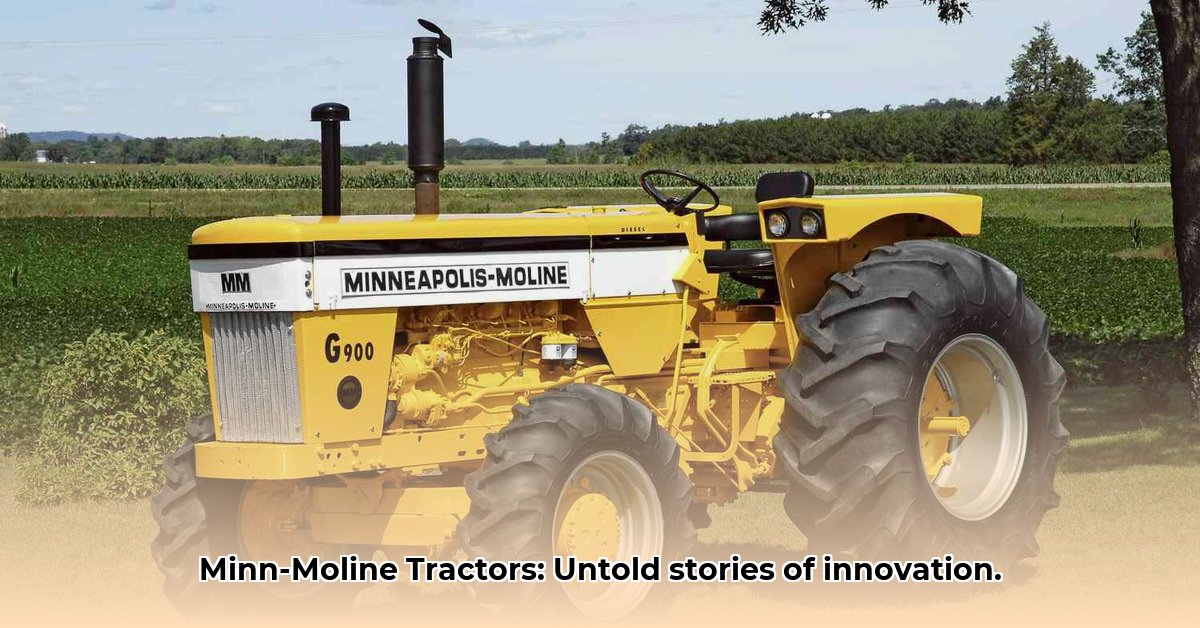
The distinctive chug of a Minneapolis-Moline (M-M) tractor evokes a potent image of American farming history. This case study explores the rise and fall of this iconic brand, examining its innovative designs, labor relations, and the challenges that ultimately led to its demise. We will analyze the company's successes and failures, highlighting the interplay between technological innovation, economic forces, and the human element within a pivotal period of American agricultural transformation. For more in-depth information, visit the M-M Tractor History.
A Giant Forged in the Depression's Shadow
The year 1929 marked not only the beginning of the Great Depression but also the birth of Minneapolis-Moline. The merger of the Minneapolis Threshing Machine Company and the Moline Plow Company, a bold move in an era of economic uncertainty, created a powerful force in the agricultural machinery industry. These early M-M tractors, built with sturdy designs and powerful engines, quickly gained recognition for their reliability and effectiveness, offering a symbol of hope and resilience to Depression-era farmers. But did this early success adequately prepare them for the future challenges that lay ahead?
Innovation Takes Center Stage: Comfort and Ambition
M-M didn't merely build tractors; they sought to revolutionize farming. Their commitment to innovation is evident in the UDLX Comfortractor, featuring a revolutionary enclosed cab. This provided farmers with much-needed protection from the elements, dramatically improving working conditions and potentially boosting productivity. But how did this innovation affect the overall cost and market accessibility of their tractors?
Even more ambitious was the Uni-Tractor system, an integrated farming system aiming to streamline all aspects of farm work. While commercially unsuccessful, it exemplifies M-M's visionary spirit and their relentless pursuit of agricultural efficiency. This bold, albeit ultimately unfulfilled, undertaking highlights the risks and rewards inherent in ambitious innovation. Did the pursuit of such a complex undertaking divert vital resources from more immediately profitable ventures?
The Human Story: More Than Just Machines
The story of M-M is inextricably linked to the people who built and used these machines. Early years were marked by anti-union sentiment, reflective of the broader industrial climate. However, a 1935 agreement with a labor union signified a significant shift in industrial relations. This change profoundly impacted production and profitability; however, the precise nature and extent of this influence remains a subject of ongoing scholarly debate. Some argue improved worker relations enhanced morale and efficiency, while others point to increased costs as placing the company at a competitive disadvantage. Further research is warranted to clarify this crucial aspect of the company's history. Moreover, the later loss of pension funds following acquisition by White Motor Corporation serves as a poignant reminder of the human cost associated with corporate mergers and acquisitions.
The Rise and Fall: Facing the Challenges
Despite innovations and early success, M-M faced considerable challenges. Intense competition, evolving market demands, and persistent labor cost pressures all contributed to the company's gradual decline. The 1974 acquisition by White Motor Corporation marked a pivotal turning point, effectively ending the era of M-M as an independent entity. This acquisition underscores the vulnerability of even the most successful companies to the forces of consolidation and changing market dynamics. What specific strategic decisions contributed to their eventual demise? The repurposed factory sites, however, stand as physical reminders of the company’s immense impact on local communities and regional economies.
Analyzing the Impact: A Multifaceted Legacy
M-M's legacy extends beyond its tractors. The company's story provides valuable insights into the complex interplay of technological innovation, labor relations, and market forces. It compels further exploration into how effective marketing strategies, financial performance, and comparable labor practices played key roles in determining the company's course. The enduring impact on various stakeholders is evident:
- Agricultural Historians: Increased focus on M-M's innovations and their impact on farming practices.
- Collectors & Enthusiasts: Growing interest in preserving and restoring rare M-M models.
- Business Schools: Case studies analyzing M-M's strategic decisions and their consequences.
- Local Communities: Potential economic development spurred by repurposing of former factory space.
A Lasting Impression: Lessons Learned
The Minneapolis-Moline narrative serves as a compelling case study illustrating the dynamic relationship between technological advancements, labor relations, and the unpredictable nature of the marketplace. It underscores the importance of adaptability, strong internal cohesion, and long-term strategic vision in navigating the complexities of the business world. The company's legacy continues to resonate, offering valuable lessons for future generations of entrepreneurs and scholars alike. The detailed study of M-M's financial records and labor practices in comparison with its competitors would undoubtedly enrich our understanding.